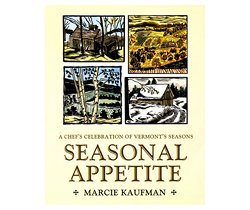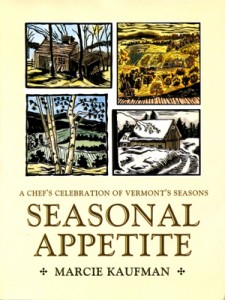
 copyright the Chronicle August 6, 2014
copyright the Chronicle August 6, 2014
by Tena Starr
Marcie Kaufman is a professionally trained chef who lives in Jay. She graduated from the New England Culinary Institute in Montpelier in 1992, but began her career earlier, in 1987, as an apprentice boulanger and patissier.
To translate broadly, that means she is a very good baker and pastry maker.
Ms. Kaufman has now written a cookbook called Seasonal Appetite, a Chef’s Celebration of Vermont’s Seasons. She says the solitude of her own kitchen has replaced the restaurant’s “animated discourse.”
“Outside my window is a pastoral landscape of pristine forested mountains, winding dirt roads, verdant meadows, and azure slivers of stream. Nature’s breathtaking beauty inspires the creation of this cookbook.”
The book’s recipes are divided by seasons rather than category of food, an unusual but interesting structure. Each chapter includes recipes for appetizers, breads, soup, salad, entrées, and desserts.
“Spring, struggling with cold temperatures, strong winds, and icy rains is nature’s new beginning,” Ms. Kaufman writes in her introduction. “Our blood thins, our appetites decrease, and our vitality awakens. The birth of nourishing green vegetables whet the appetite for salads of tender lettuces, and the fresh-caught flavor of fish from ice-free rivers, lakes and streams.”
Spring recipes include borscht (which I think of, personally, as a fall recipe), poached blue mussels vin blanc, poppy seed dinner rolls, lamb chop and Fava bean ragout with whipped potatoes, and pistachio sponge cake with Mascarpone cheese frosting and chocolate sauce.
Summer, Ms. Kaufman says, is obviously the growing season. “We refresh the appetite and cool our bodies of summer’s heat with chilled vegetable soups, zestful salads, and the juicy sweet fruits of summertime.”
And autumn is the season of harvest. “We are drawn indoors to the comforting warmth of the wood stove. As our blood thickens in anticipation of winter, the appetite is tempted by the hearty full flavor of enriched soups, and succulent wild game.”
Winter in Vermont is, of course, a challenge when it comes to seasonal ingredients. “Cold days and long darkened nights persuade the appetite to warm our bodies with velvety-sauced entrées, hot buttery breads, and rich creamy desserts,” Ms. Kaufman writes.
“Celebrate nature’s abundance. Whet, refresh, tempt, and persuade seasonal appetite with inspired meals created in your own kitchen. Listen. Vermont’s seasons beckon….”
It’s a lovely notion, but the problem arrives when you get to the recipes, which I assumed were for a good home cook. Ms. Kaufman tries mightily to explain how to get there, but many of these recipes will be hard to replicate in a Vermont kitchen.
But she is so clearly a foodie and a chef, so obviously has put considerable thought into how to translate an excellent restaurant meal into a home kitchen, even including definitions for culinary terms such as “chiffonade.”
But I stumbled on the very first recipe: Asparagus, Vermont blue, and mâche, with blue cheese vinaigrette. It’s a wonderful salad recipe, but mâche is hard to get. It’s an early green, also called corn salad, that’s by no means readily available here, unless you grow it yourself.
Mâche, which has a slightly nutty flavor and some tang, could be replaced by another green, but the recipe also calls for champagne vinegar, and I have no idea where to acquire that, although it sounds elegant.
Subsequent recipes don’t exactly coincide with Vermont’s seasons. For instance, baby beet, arugula and hazelnut salad doesn’t work, if you’re relying on seasonal ingredients. Arugula does, indeed, show up in spring, but baby beets don’t, at least not in my garden. It’s August, and I’m just beginning to have baby beets.
We are familiar, by now, with the local food movement and the efforts of restaurants, and cooks in general, to prepare meals with local, seasonal ingredients. So there is that expectation from a cookbook that claims to be seasonal.
But perhaps Ms. Kaufman is less interested in what’s available for food, seasonally, in northern Vermont than in what we feel like eating in a given time of year.
The latter makes perfect sense to me. A salad is never better than fresh out of the garden in spring. Come fall, I have less of a craving for greens. Beets, squash, corn, and beans are preferences, heartier fare as Ms. Kaufman suggests we’d want at the onset of winter.
And many of these recipes do start with an ingredient that might be locally seasonal, such as cream of parsnip soup for fall, as well as venison roast with sun dried cherry sauce.
For the home cook, or most home cooks, at least here, this cookbook will prove to be something of a challenge. I’d love to try the recipe for dressed brook trout stuffed with Bell pepper pesto, with red wine sauce steamed spinach and shallots — a spring recipe. But it would take some traveling to round up all the ingredients.
Several recipes call for homemade veal stock, which involves seven pounds of veal bones, another ingredient that’s tough to get here.
And there are recipes in this book that I’d try, but can’t figure out how, basically because I’m an American who’s never learned the metric system. The recipe for black pepper scented ice cream calls for 375 milliliters of milk and 125 grams of granulated sugar.
I don’t have measuring cups that read in milliliters and grams.
Don’t buy this book thinking it offers creative recipes for what might be growing in your garden this month. But don’t dismiss it either.
It’s easy to read, the instructions are detailed, and it does, indeed, have some terrific advice and wonderful recipes. But there are few quick meals here. That’s not what it’s intended to be.
For instance, here we are in summer and Ms. Kaufman recommends roasted pork loin with rhubarb sauce and glazed yellow and green beans.
Here is the recipe:
2 and 3/4 pound boneless pork loin, trimmed
1 clove garlic, halved
Dried thyme, as needed
Sweet Hungarian paprika, as needed
Freshly ground pepper, as needed
Olive oil
1-1/2 cup fresh rhubarb, chopped
1-1/2 ounces granulated sugar
1/2 pound of yellow wax beans
1/2 pound of green beans
2-1/2 ounces unsalted butter, cold and divided
3 tbsp. shallots, minced
1 tsp. garlic, minced
2 ounces dry white wine
16 ounces of chicken stock
1/2 tsp. arrowroot combined with 1 tsp. cold water for a slurry
A small bay leaf
2 ounces of port wine
Rub the pork with garlic and season generously with thyme, paprika, and black pepper. Rub lightly with oil. Then let it sit there for half an hour. Heat a ten-inch cast iron skillet over a medium-high flame. Season the pork with salt, and sear evenly until golden. Roast pork at 325 until it has an internal temperature of about 140.
Combine the rhubarb and sugar in a small bowl and allow it to soften for 30 minutes, stirring occasionally.
Pour about two inches of cold water into a three-quart saucepan and season with salt. Half fill a medium sized bowl with ice and water. Snap off the ends of the beans and remove any tough strings. Arrange yellow beans loosely in a steamer basket. Bring seasoned water fully to the boil, insert basket, and cover. Steam until beans are tender yet crisp to the bite. Immediately shock in ice bath. Repeat the procedure with green beans. Drain beans thoroughly, combine and refrigerate.
Transfer the roasted pork to a baking sheet and tent it lightly with foil. Place the skillet over a low-medium heat, add a half-ounce of butter and melt. Stir in shallots and garlic, season with black pepper, and briefly sweat. Adjust flame to high, stir in white wine, and reduce until syrupy, stirring constantly. Stir the slurry. Immediately whisk in stock, slurry, bay leaf and accumulated pork juices. Skim and discard impurities and reduce to a thin sauce consistency. Adjust flame to medium, stir in rhubarb and port, and cook to develop depth of flavor, stirring occasionally. Remove from heat, and whisk in one ounce of butter. Remove bay leaf and adjust seasoning.
Pour two ounces of water and remaining butter into a ten-inch pan and bring to a boil. Add the beans, season lightly, and toss until the liquid evaporates and the beans are evenly glazed and hot.
But I don’t mean to discourage. This is a serious cookbook with recipes that sound absolutely delicious and instructions that make it possible to follow them. In fact, they are not as complex as they initially sound. It’s just that Ms. Kaufman leaves little to chance or guesswork, thoroughly explaining each step.
“The recipes are classic formulas, researched and reinterpreted to offer Vermont ingredients at their seasonal peak of freshness, flavor and nourishment,” the book says. “Celebrate nature’s bounty with the creation of a memorable meal to nourish and satiate seasonal appetite.”
The book is published by iUniverse, Inc., Bloomington, Indiana. The art is done by Jeff Gold. It’s a paperback and the price is $29.95.
contact Tena Starr at [email protected]
For more free articles from the Chronicle like this one, see our Reviews pages. For all the Chronicle’s stories, pick up a print copy or subscribe, either for print or digital editions.







